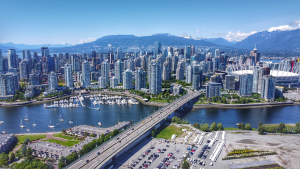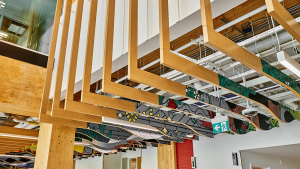When construction of two rail tunnels below, what is arguably the most congested highway interchange in North America, wrapped up last summer, more than just earth was moved.
Completed by Toronto Tunnel Partners, consisting of EllisDon and STRABAG, the simultaneous construction of the two 180-metre-long tunnels with the use of three Bohrtec BM 800 machines helped bring a $959-million expansion of the Kitchener, Ont. to Toronto GO Train service one step closer.
“It (the tunnel project) will help increase service in the future,” says Metrolinx communication spokesperson Nitish Bissonauth.
The construction of those tunnels under Highway 401 and 409, which are a pivotal foundation of the expansion, occured less than three metres below the surface without disrupting the 21 live traffic lanes directly above.
In a review of the project, with its large public interest and major investment, EllisDon construction manager Joshua Manning, notes there were a myriad of planning, logistical and construction challenges
“Multiple stakeholders were involved, so the Toronto Tunnel Partners (TTP) scheduled numerous start-up meetings following the project award.”
That close communication continued throughout the planning period into the construction stage. To keep the work aligned with Metrolinx’s requirements, TTP provided timely construction progress reports and information to enable key decision making together with all stakeholders involved. And to strengthen that strong collaboration and partnership, it also hosted a facilitated partnering session each year of the project, he says.
As the backbone of the 400-series network, a key requirement was ensuring that the Highway 401/ 409 interchange remained operational at all times.
With only limited temporary lane closures permitted and the numerous lanes of busy traffic above ground, the TTP team used a unique alternative to conventional cut-and-cover tunneling called the sequential excavation method (“SEM”).
“This method involves a cyclical excavation and support sequence that is carried out within the individual tunnels to enable safe and stable excavation which also ensures existing structures and utilities are protected.”
Tunneling under all those lanes of traffic also posed numerous safety risks. To ensure that workers were kept safe, and traffic wasn’t impeded, the project featured a complex network of monitors that covered the highway surface, as well as the tunnels and the adjacent surrounding area.
“These instruments tracked minute movements including traffic going over the road, contraction and expansion caused by the changing seasons, and reactions to extreme events such as vehicle collisions.”
The system allowed the project team to understand the natural movement of the highway, identify any deviations, and enhance project safety for both the work crews and the travelling public, he says.
Meeting the schedule was also a challenge and to ensure the project was completed within the required timeframe the project team implemented a number of strategies and procedures including erecting an on-site concrete batch plant to lessen the reliance on concrete deliveries, says Manning.
The provincial government transit planning agency is carrying out the multi-year, multi-phase development to provide two-way all-day service along the rail corridor. That service enhancement was identified by local communities along the route as a priority to support growth and economic development, says Bissonauth.
Service increases have been limited because a portion of the Kitchener line between the Bramalea and Kitchener GO train stations is actually a freight rail corridor owned by CN. And that is the reason this expansion is an umbrella of two separate—although related—ventures.
“The first is the GO Expansion program – which will bring two-way, all-day service between Bramalea and Union Station (the terminal station in downtown Toronto) every 15 minutes or better.”
For the portion between the Bramalea and Kitchener stations, Metrolinx has been working with CN on several other initiatives such as the design of improved infrastructure services rather than constructing a separate freight bypass corridor, he explains.
Besides the rail tunnels, a considerable amount of work at the Mount Dennis, Weston, Malton, Bramalea, and Brampton GO stations has and is taking place in anticipation of the improved service. That is particularly the case with the Bramalea station.
“We’ve done a lot of work at the station and customers using Bramalea GO now have access to a new, open-air parking garage that can accommodate 2,059 vehicles.”
A major feature of the parking structure is a brand-new car counting system that identifies which levels have vacant spots – blue for accessibility, green for all other vacancies, red for occupied. Other work at the station includes the construction of a recently opened new bus loop for both GO Transit and Brampton Transit buses, says Bissonauth.
Asked about the next steps in the expansion, he references the April agreement between Infrastructure Ontario and Metrolinx with ONxpress which enables the consortium to design, build, operate, and maintain the infrastructure and trains for 25 years along the GO network. ONxpress is comprised of Alstom, Aecon Group, and Deutsche Bahn International Operations as well as FCC Construcción.











Recent Comments
comments for this post are closed